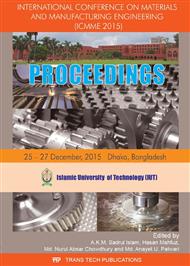p.46
p.52
p.58
p.64
p.70
p.74
p.81
p.87
p.93
Development of a Passive Damping Tool Holder for the Improvement of Surace Roughness in Turning Operation of Stainless Steel
Abstract:
One special type of passive damping setup has been used to investigate the surface responses with the variation of different process parameters. In this study, a special design capsule type tool holder has been used to investigate the process parameters effect in machining of stainless steel during turning operations under different cutting condition such as-RPM, feed, depth of cut. Inside the capsule high viscous fluid is used as damping materials and its effects has been investigated accordingly. The effect of damping during turning process is investigated by studying generated surface profile for both with and without damping system. It has been observed that surface roughness is better in the newly designed passive damping tool holder compared to normal cutting conditions.
Info:
Periodical:
Pages:
70-73
Citation:
Online since:
December 2016
Price:
Сopyright:
© 2017 Trans Tech Publications Ltd. All Rights Reserved
Share:
Citation:


